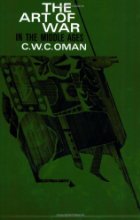 Art of War in the Middle Ages A. D. 378-1515 by C.W.C Oman
Art of War in the Middle Ages A. D. 378-1515 by C.W.C Oman
Paperback: 194 pages
Publisher: Cornell University Press; Revised edition (June 1960)
ISBN-10: 0801490626
Art of War in the Middle Ages covers the entire period of warfare in medieval history, from the fall of Rome to the early 16th century. If you’re looking for a book that details battle strategies and tactics of armies used throughout medieval Europe and the Byzantine Empire, and how those tactics evolved offensively and defensively, then I’d highly recommend Oman’s study of this subject. The author breaks down each chapter and focuses on a particular region or army or fighting style. He also includes the strategies involved in several key battles during this period.
Chapter one discusses the transition from Roman to medieval forms in war, including the disappearance of the legion, the Battle of Adrianople, the Goths and the Huns, and the rising importance of the cavalry.
Chapter two transitions to the Early Middle Ages (appx. 476 – 1066) and focuses mainly on the Franks and the armies of Charles the Great. This chapter also touches on the Norsemen, the Anglo-Saxons, the rise of feudalism, and the Danes. It ends with a look at the Battle of Hastings.
Chapter three moves out of medieval western Europe and takes a look at the Byzantine Empire.
Instead of focusing on a region or particular country, chapter four focuses more on the strategy behind the feudal cavalry. Here you’ll learn about tactical arrangements, the consequences of headlong charges, the weaknesses of infantry, the rise of mercenaries, the importance of fortified places, the medieval siege, and the general character of campaigns. The chapter wraps up with the Crusades.
Chapter five returns to a specific country and details the supremacy of the Swiss army and its notorious pikeman.
Chapter six introduces a new force to the medieval battlefield, a soldier that would rise above the cavalry in importance and destructive ability: the English longbowman. The longbowman’s capabilities are especially demonstrated in the Battle of Crecy and the Battle of Agincourt. The chapter concludes with a look at Edward IV, and with the Wars of the Roses.
Chapter seven is the final chapter and a bit off-beat and obscure in topic. It details the Ziska, the Hussites, the Ottomans, and other nations of Europe.
Art of War in the Middle Ages is written for the medieval enthusiast as well as the academic. Highly informative and entertaining.
My rating: 4 out of 5 stars.
Thanks for this – adding to my To Read list as we speak!
You’re very welcome. Hope you enjoy it. I’ll be interested to see how you like it.
??????????????????QQ?306478122????:???